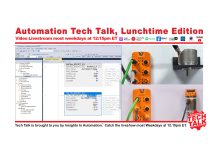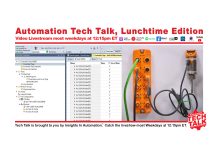
In today’s article, Jeff Turcotte of PLC Concepts discusses winder and slitter positioning control system upgrades, and how his company’s upgrades increase throughput and reduce downtime.
Written by Jeff Turcotte, PLC Concepts Inc:
Over the Holidays I had the pleasure of catching up with Shawn Tierney who I’ve known for many years prior to his launching of The Automation Blog and The Automation School.
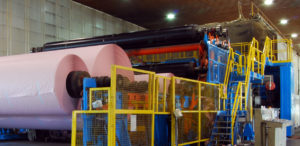
As we were talking, he suggested I share my story about how I built a successful business helping Paper Mills upgrade the automation systems on their legacy Winder and Slitter Positioning Systems, and that’s what I’ll share in today’s article.
First, let me share a little of my background with you.
I started in the paper industry back in 1986, working for Jagenberg, a company that made paper finishing machines.
After several years I decided to start my own company, PLC Concepts Inc, and the mainstay of my business has been performing upgrades on existing equipment in the paper industry.
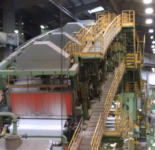
Along the way I’ve also branched into other areas, including acting as a service contractor for Rockwell, as well as designing control systems for baking equipment and biofuel conversions.
Most of the control systems I’ve used over the years have been centered on Rockwell products, from PLC-2s through ControlLogix and Studio 5000, as well as the various Rockwell HMI software packages.
That said, I’ve also had the opportunity to design and deploy control systems using Modicon, GE Series 6 and 90/70, Siemens S5 and S7, as well as Variable Frequency Drives from multiple vendors.

Upgrading Legacy Winder and Slitter Positioning Control Systems
The methods you choose to upgrade an existing control system on a Winder (or any piece of equipment) obviously depends on the installed control system, as well as the type of control used.
Many of my clients have control systems from Rockwell, and those with PLC-5 systems are typically very interested in reusing the installed I/O.
That may seem odd at first, until you realize many of these systems have up to a 1000 I/O points, and replacing and rewiring all that I/O would add substantial cost to any project. Though the bigger factor is the down time it would take to accomplish the task, with the potential for possible wiring errors
But regardless of the brand, upgrading existing equipment is a methodical task as you’re working with an existing program written many years before.
So prior to bidding any project, I make the following request of my customers to insure I’ve covered all the bases:
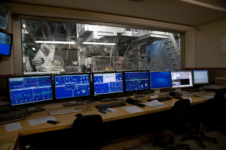
- Can I observe the machine running and speak with the operators?
- Did the program run properly to begin with, and is all the original functionality still available or desired?
- Are there any mechanical underlying issues or planned upgrades?
- Are you looking to improve performance as the primary end goal, or is your goal more consistent uptime?
- Does the machine interface with any auxiliary systems, and if so are they using legacy software/hardware?
- How much downtime are you looking to allocate to do the project, and what is the production expectation after the initial work has been done? When do you expect to be back at 100% capacity?
- Who is maintaining the system after the fact, and will any of these people be available to work with me during the conversion?
While the aforementioned questions might seem to be obvious, are they? Do we as controls integrators take things for granted when upgrading legacy systems?
Many would assume that the original program, which has been running for years, had to be solid. Otherwise, it would have been modified to correct any issues along the way, right?
Well, that’s not necessarily the case, as fact I was reminded of a few years ago when I broke my own protocol.
While I’ve found Jagenberg’s basic machine programs to be very robust over the years, I was once tasked with upgrading a system that was one of only a few machines built in that style.
And it turned out to have a very complex unloading sequence that was poorly written, something I didn’t realize that at the time.
After converting the equipment from Reliance Automax to ControlLogix, I began to run into a ton of issues.
Of course, now I owned the program so there was no going back.
After talking with several operators about what problems had always existed, I decided to rewrite that portion of the logic.
It was a costly reminder, which also added an extra week to the project.
Fortunately, the customer also saw the need to correct the original faulty code, and compensated me for the additional time onsite required to implement the changes.
I’ve also found over the years that, regardless of what industry a system comes from, higher end automation functionality was seldom put into the PLCs in the late 70’s and even into the early 90’s.
Third party HMI software was also non-existent during that time, so companies often made their own proprietary systems.
These proprietary systems acted as an interface and controller, and were often coupled with custom electronics that handled the actual machine functions and interface with the PLC’s.
That was the case at Jagenberg, where these types of systems handled Nip Pressure, Tension, Load Sharing, Diameter/Length Stops, and positioning of the Slitters/Stations corresponding to requested roll sizes.
Sometimes we only upgraded just the automation portion of the system, including retrofitting positioning portion. Regardless, to do away with these systems you had to engineer your own replacement solution from scratch.
And since the original programs were compiled, you couldn’t view the original code and therefore had no idea what was in the original logic.
As you may know, many companies run their systems until they just don’t work anymore. Or until it has an adverse effect on production.
So when I first began retrofitting positioning systems, I needed to analyze why and where they were failing.
In my first project there were several issues, including two mechanical points of failure, one maintenance related issue, and two evolving production related problems based on current customer demands:
- The existing systems used encoders as feedback for the position of the slitters. The wiring was done through ribbon cables set up in a festoon. The cables were starting to break down and so was everything related to the encoders themselves causing potential errors in the system.
- The mechanical portion of the slitter systems were also worn out causing excessive friction, skewing, and finally clamping issues. These issues were a root cause in preventing the system from finishing requested positioning sequences reliably. Truth is when you run machines 24/7, it’s hard to keep up with the recommended maintenance.
- Since the systems were proprietary, they were almost impossible for the mills to maintain themselves (I also work with a consultant who use to troubleshoot and repair these systems.)
- Standards for production were changing, and originally the customers who used the finished rolls always trimmed prior to processing the paper. This produced excessive waste and the tolerances the customer would accept became stricter. Back when I started in the industry roll sizes could be as much as .25 inches over and .125 inches under. Now you can be no more than a .03125 inches over and nothing under.
- Finally, the way paper was made changed! Not necessarily the process itself, but the way orders were handled. Mills would make paper and store the rolls based on projected demand. So the machines might run specific roll sizes for days sometimes on a certain grade storing the finished product. This model shifted to manufacturing upon request, resulting in more size changes per shift. The result being the initial accuracy of the slitters and the time spent positioning now totally impact line performance.
That said, large scale mechanical rebuilds of slitter sections are typically not going to get funded.
They’re costly, and required more downtime than most mills want to give up.
The best you could hope for was to get them to repair the specific components in certain slitters, and possibly replace all of their bearings.
But given how sloppy the systems became through mechanical wear and tear, we had to find a way to get around these deficiencies.
Technically, you could reuse the Jagenberg encoders by wiring them into any 16 bit DC sourcing input like an Allen-Bradley 1756-IV16.
And in certain instances, we did this, especially related to the stations on a Single Drum Winder using Grey-Code to Binary conversion.
Reality is, this does nothing to eliminate the potential wiring issues related to the festoon.
In the pursuit of finding a solution to that issue, I was led back to a company I was exposed to at the end of my time with Jagenberg.
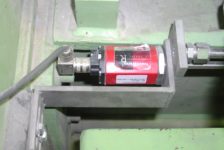
The company is MTS Sensors, who I have been privileged enough to develop a long-term relationship with over the years.
MTS makes a myriad of products that use a time-based magnetostrictive position sensing principle based on the position of a magnet, or multiple magnets, relative to a wave guide.
This wave guide is inserted into a tube which is attached to a head that contains an on-board processor.
The processor then converts the signal into the specific communications protocol you want to use.
Using this device with a singular power/communications connection at each head eliminated the encoder and wiring issues.
NOTE: You can read the MTS case study on one of Jeff’s project here.
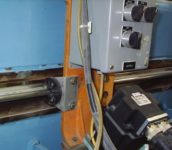
Going forward we decided that upgrading positioning systems would revolve around this sensor, and looking back it was a good choice.
With an understanding of why the systems were failing, and through observation on my own time, I was able to understand the intent of the original design which then lead to the solution for mounting the new sensors and magnets on each element.
When I first started working on these systems, the PLC-5 was the most common controller, so I used a RS-422 signal with a start-stop style sensor that was wired directly to a 3rd party card in the HMI computer.
This data was then mapped into RSView32 through a Visual Basics program that polled the sensor.
Then the data was sent to the PLC to be used in the positioning sequence.
While this method did alleviate many of the initial wiring and mechanical issues, it didn’t improve the speed of the sequence, or the accuracy of the slitter elements in a pattern.
It wasn’t until about 15 years ago when MTS made a significant breakthrough with the material used to manufacture its waveguide.
This upgrade of the MTS product made a huge difference relative to the accuracy monitoring up to 15 magnets per sensor.
Coupled with that, they were able to extend the overall length of the sensor from 300 inches to 480 inches, along with a more flexible style that alleviated many of the installation and maintenance issues.
At the same time, they were also moving into Canbus/Profibus networks, which allowed the positioning data to go directly into the PLC via a 3rd party communications card.
This was a major hardware upgrade, which happened around the same time that ControlLogix was becoming the standard for many Paper Mills.
It was as that time that I also started using the SST Profibus card with these systems (SST is now owned by Molex.)
The current iteration of that card is the SST-PB3-CLX-RLL, and it is a 1756 rack based style.
Moving to the ControlLogix, the new MTS system, and the SST module changed everything, and enabled us to dramatically improve the original positioning sequence making it both faster and more accurate.
The HMI portion was also upgraded to FactoryTalkView, and allowed the operator to enter the roll sizes that our own algorithm would use to pick the appropriate slitters to use.
The last component to address for these upgrades is the motor itself, and how it was controlled.
They were originally standard European AC motors wired for 380, and capable of 220.
The initial Jagenberg systems used these motors to position the slitters via standard AC motor contactors.
The course movement was done by leaving the starter “on” based on a projected “millimeters per second” timed interval relative to the slitters last known position.
This was a limitation of the original system electronics because it could only look at one encoder at a time.
It is worth noting that Valmet/Metso and Beloit positioning systems have similar limitations, though for different reasons.
But now with the MTS sensor, we knew every position all the time. And since it had an update rate of 5 milliseconds, the PLC program had position feedback in real-time.
Once all of the slitters reached the course positioning target, the system would then switch over to a VFD acting as a variable step-down transformer for a certain group of motors.
Initially, all of these motors were of the pre-PWM era, so the drives either required filters/reactors, or had to be rewired to 220 to avoid issues.
Once this drive was in use, the fine positioning was done via a timed pulse, followed by a position verification wait time.
This cycle was repeated until the target position was reached without error.
Standard modules like the 1756-OW16I or OA16 have reasonable on/off cycle times, but the AC coils have inductance which needed to be considered in the timing.
If possible, you would want to update the contactors using DC coils, and add a 1756-OB16I or OB16D card to your PLC rack.
For optimal individual control, you can replace the contactors with PowerFlex 525 VFDs on Ethernet for a reasonable price comparatively.
Either of these options gives you the absolute best performance, keeping the positioning sequence at 30 seconds or less for almost any pattern.
This is a vast improvement over the 60 to 120 seconds it takes to position the slitters with the previous system when it’s running well.
And keep in mind that, at the end of their life cycle the original systems might have taken several attempts to reach their target settings.
Regardless of the design style of the original slitter system, the core of our new design is applicable, and extends the usefulness of the current mechanical components of any slitter beam.
And considering the alternative, which is total replacement, this upgrade option is a very acceptable solution.
It’s also worth mentioning that beyond slitter positioning, I’ve also used the MTS sensors for a multitude of positioning, size change, and general feedback applications, as the application demanded.
As I hope you can tell from this article, I feel strongly that mechanical aptitude is as big a component as electrical/programming abilities when it comes to upgrading Winder and Slitter systems, and insuring a positive outcome from your upgrade.
Thanks for reading, and remember: safety first!
Jeffrey C. Turcotte
Electrical Integrator And Programmer
PLC Concepts Inc
Website: PLCConcepts.com
Email: jturcotte@plcconcepts.com
Phone: (413) 650-0085
LinkedIn: Jeff Turcotte
Editors Footnote:
I want to thank Jeff for taking the time to write this article and share with us how he’s made a successful business upgrading Winder and Slitter Positioning control systems for Paper Mills.
Having worked with Jeff for many years outside of the Paper Industry, I have to say I really enjoyed learning about this side of his business.
If your plant has a Winder or Slitter Positioning system which needs upgrading, I would highly recommend reaching out to Jeff via his contact information above.
And if you’ll like to join the ranks of our guest bloggers, please let me know using the contact form here.
Sincerely, Shawn Tierney of The Automation Blog.

Discover more from The Automation Blog
Subscribe to get the latest posts sent to your email.


